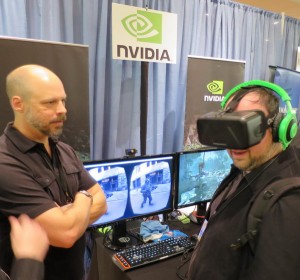Personal Eyewear – Since 2012, Display Central has published roughly 60 articles that discuss the Oculus Rift. I’ve reviewed most of them and not one of them mentions the terrible image quality produced by the head mounted virtual reality (VR) system.
A more common type of headline is “Oculus Rift at SXSW: Is Virtual Reality the Holy Grail of Gaming?”
A Google search for “Oculus Rift” produces 22,500,000 hits, although I haven’t reviewed all of them. On the first 12 pages, however, I didn’t find any mention of the poor image quality either. Have you ever gone to page 12 on Google results? There you start to find web pages in Chinese, Romanian, Spanish, Russian and German. A typical hit was from a recent article in Wired titled “The Inside Story of Oculus Rift and How Virtual Reality Became Reality.” Well, maybe, but not yet.
As everyone in the display community knows, Facebook bought start-up Oculus earlier this year for $2.0 billion, plus a $300 million “earn-out option”. Not bad for a start-up that had been begging for money 18 months earlier on Kickstarter. People questioned why Facebook was interested in Oculus, including Display Central’s Norbert Hildebrand. After all, a VR system is very far away from Facebook’s core competencies and its profit base. Maybe Facebook wants to expand into new markets.
This article isn’t about why Facebook bought Oculus. It’s about why anyone would want to buy an Oculus HMD, at the consumer level. Sure, there are technophiles and gamers and early adopters out there that will buy them, but I doubt it will be in sufficient numbers to justify a $2+ billion price tag, plus whatever Facebook has poured into R&D since March.
I tried the Oculus Rift at a recent Pepcom Event in New York City. Facebook/Oculus wasn’t there but NVIDIA was. NVIDIA is a key supplier of graphical processing units (GPUs) for the Oculus Rift.

First the good news. In the approximately one minute demo sequence with an alien monster (AM) that was destroying New York (or some place), the head motion sensor/image generator (IG) combination worked flawlessly. When you turned your head, the image moved with no noticeable lag to what your eyes were now pointing at. When the AM blasted a car and it flew over your head, you could look straight up and see inside the car, the driver still wearing his seatbelt. When you turned your head and looked beside or behind you, you could see the soldiers firing their laser machine guns (quite uselessly) at the AM.
Now the bad news – the resolution was terrible. The Oculus Rift development kit 2 has 960 x 1080 resolution per eye, spread over a 100° field of view. To put this in perspective, this is about 0.75 picture heights away from the screen. It’s like sitting 23.8” away from a 65” TV. At this close distance, you’d probably see pixels in a 4K UHD set and certainly would see them in an HD set. At somewhat less than ½ HD resolution, the pixels in the Oculus Rift were very obvious.
I asked the NVIDIA representative about the low resolution. The question seemed to make him happy as a clam. The resolution in the Oculus is limited not by the available displays – displays with very high pixels per inch are available – but by the processing needed to make sure the image tracked the head motion with no noticeable lag time. If you want more pixels in your image, you just use more NVIDIA GPUs to do the image processing. Or perhaps use a larger, faster, newer, custom and more expensive GPU – NVIDIA isn’t likely to mind either way.
Another image quality image was misconvergence of the red, green and blue. This was not due to the low resolution, although low pixel counts can mimic misconvergence. It was also visible in the HD monitor in the NVIDIA booth repeating the left and right eye images shown on the Oculus Rift. This isn’t such a serious problem as resolution and I’m sure Oculus/Facebook/NVIDIA will be able to solve it, once they realize it’s an issue. If they can’t solve it, they can just call Scalable Technologies – it knows how to solve image alignment problems.
There were two more issues that are more marketing issues than technical issues. First, you have to wear the Oculus Rift on your head. One of the reasons given for the failure of 3D TV was the need to wear glasses to see the image. Yet there are people who wear their glasses all their waking hours and it doesn’t seem to bother them at all. And glasses don’t weigh 0.44 Kg (0.97 pounds) and have a cable and IR head tracking system tying them to a computer, the way the Oculus Rift Developer Kit 2 does. Wireless connection? Well, maybe. But then you’d be wearing the battery either on your head (making the Oculus even heavier) or on your belt (where your head would still be tied down with a cable).
The second problem is custom content. 3D TV content is different from 2D TV content and it proved to be prohibitively expensive to produce both 2D and 3D versions of the same content for the small number of viewers of 3D TV. VR game content is different from conventional 2D game content and significantly more complex and expensive to produce. ill the small number of Oculus Rift users justify the development of custom VR games just for them?
Time will tell but, obviously, I don’t have very high expectations of the long-term future of VR in general and the Oculus Rift in particular, at least not as a consumer product. The only other anti-VR voice I found searching Google was James Cameron. Well, at least I’m in good company. – Matthew Brennesholtz

